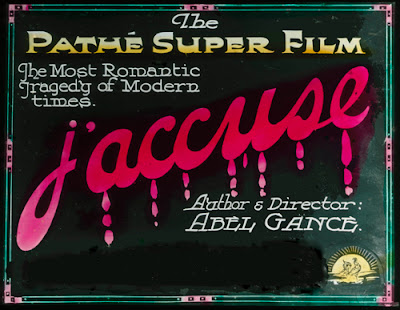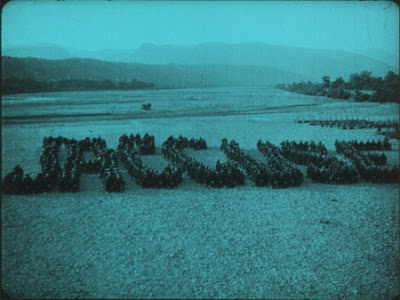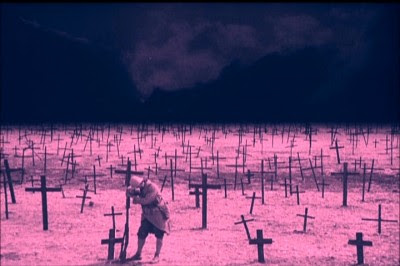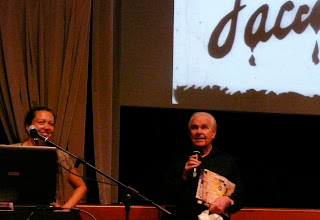Abel Gance’s J’Accuse
November 6, 2010
On December 12, 2009 the San Francisco Silent Film Festival presented the North American premiere of Abel Gance's epic J'Accuse. Never released in United States in it's original form, the film finally made it to American shores a mere 90 years after its European release thanks to the multi-year collaborative restoration undertaken by Nederlands Filmmuseum and Lobster Films. The text that follows is my original program essay from the San Francisco premiere.

Five months after the armistice was signed that ended World War I, Abel Gance premiered his epic J’Accuse in Paris. Called the Great War, WWI was also dubbed “the war to end all wars,” and Gance’s film was aimed at making that statement a reality. Many of his own friends had been killed in the trenches, and, as Gance later explained, “J’Accuse for me was not just a film …. I had a feeling of frenzy to use this new medium, the cinema, to show the world the stupidity of war.”
J’Accuse was not the first antiwar film, but the way Gance told his story, using expressionistic camerawork and innovative editing techniques, profoundly influenced filmmaking from Hollywood to Moscow. At age 20, Gance began working in films as a scriptwriter and actor. Two years later, in 1911, he formed a production company and directed the one-reel costume drama La Digue (or Pour sauver la Hollande). He followed his debut with several other popular short narrative films before the war intervened, decimating European film production. In 1914, Gance volunteered as a civilian stretcher-bearer. He was soon drafted into the French Army and assigned to the cinematographic section. He described the experience as “a preposterous business” but managed to avoid photographing at the front. His final assignment was at a poison gas factory, and, in 1915, the army discharged him after he was diagnosed with tuberculosis.
Gance returned to filmmaking with La Folie du Docteur Tube (1915), a short avant-garde comedy photographed using mirrors to create distorted images. In 1916, he wrote and directed his first feature-length films, society dramas for the French production company Société de Film d’Art, where he experimented with the cross-action editing developed by D.W. Griffith, extreme close-ups, tracking shots, and other techniques that became essential to cinema’s visual language.

Gance began writing the scenario for J’Accuse in 1917. “I believe,” he wrote in his journal at that time, “that the social significance of J’Accuse is profound and that the film will triumph everywhere and nothing will shackle its purpose.” The main story is a love triangle, which becomes complicated by the on-set of war. Jean, a pacifist poet, is in love with Edith who is unhappily married to François, a brutish provincial farmer. When war is declared, both men join the army, serving in the same front line regiment. Battling the Germans together, Jean and François reach an uneasy truce between themselves. Meanwhile back at home, a suspicious François had sent Edith into exile and, perhaps intentionally, into harm’s way.
For Gance and his colleagues, the horror of war was not an abstract notion. Most of the letters used in the film’s intertitles were actual letters home by two of Gance’s friends, both of whom were killed. The extras in battle and the dead on the battlefields were actual soldiers. “There were great numbers of soldiers coming to the Midi on eight-day passes—a little breather after four years at the front,” Gance later explained. “I asked the local HQ if I could borrow two thousand. These men had come straight from the front …. They had seen it all, and now they played the dead knowing they would probably die themselves. In a few weeks or months, 80 percent of them would disappear. I knew it and so did they.”
J’Accuse’s release so close to the end of the war amplified its impact on the European public. After the French premiere, the British trade newspaper Kinematograph Weekly accurately predicted, “J’Accuse has created a furor in its native France, it will do the same wherever it is shown in Britain.” After the film opened at London’s Philharmonic Hall, the London Times reported, “The miracle has been achieved. A film has caused an audience to think,” and a review in a later issue of Kinematograph Weekly called it “… one of the most terrible indictments against war which it is possible to imagine.”

European newspapers praised the film, and Gance became recognized as one of the continent’s most important directors. Yet two years passed before J’Accuse crossed the Atlantic. American distributors were typically cool to foreign films, and J’Accuse’s long running time and pacifist message were also considered liabilities. In May 1921, Gance traveled to New York to promote the film at a preview for theater owners and the press. The screening took place at the Ritz-Carlton, and the 400-person audience included D.W. Griffith and Lillian and Dorothy Gish. Griffith was so impressed that he invited Gance to his studio and subsequently arranged for the film to be distributed by United Artists.
Despite the enthusiastic preview reception, J’Accuse was dramatically altered for its American release in October 1921. Renamed I Accuse, the film was given a happy ending and Gance’s antiwar message was distorted into an endorsement of patriotism. American critics who had attended the original preview decried the mutilation. “To those who saw the original J’Accuse, or have heard of it, “lamented the New York Times, “it is necessary to say, first of all, that I Accuse is not the same thing.” A later New York Times article summarizing the film events of the year concluded that “… Abel Gance’s terrific J’Accuse … was so emasculated before it reached the public screen under the title I Accuse that it must be counted as lost.” Predictably, the Americanized I Accuse, released to an indifferent public, was not a commercial success.
A similar fate befell Gance’s two epics of the 1920s, La Roue (1921) and Napoléon (1926), neither of which reached American audiences in their original form. In these films, Gance expanded the repertoire of film technique by further developing his innovations of widescreen and split-screen imagery, rapide montage (quick-cut editing), and expressive camera movement, all of which influenced cinema far beyond the silent era. Russian director Sergei Eisenstein personally thanked Gance for teaching him the art of film, and, in 1979, historian Kevin Brownlow declared, “If D.W. Griffith gave us the grammar of film, then Abel Gance gave us an encyclopedia for the new art form with his heroic achievements.”

Ninety years after its European premiere, American audiences can finally watch Gance’s J’Accuse as he meant it to be seen. In 2007, Nederlands Filmmuseum and Lobster Films joined forces to restore the European release version of J’Accuse. They combined source material from six different prints, including one reel of Gance’s original camera negative and the only extant print featuring the original tinting and toning. Warped and shrunken sequences were stabilized and film frames cleaned of scratches, nitrate deterioration, mold, rust, projector oil, and, in one case, even a squashed bug. The final climactic reel of J’Accuse now retains Gance’s intended combination of blue toning and lavender tinting, creating a surreal effect in the haunting finale. At the end of the restoration process, two 35mm release prints and a preservation negative were produced, ensuring that J’Accuse survives for generations to come.
--- ROB BYRNE (December 2009)
